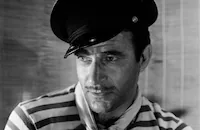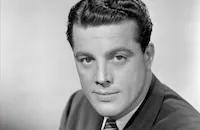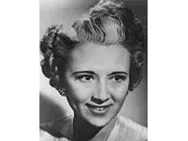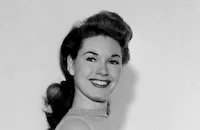The French Line

Brief Synopsis
Cast & Crew
Lloyd Bacon
Jane Russell
Gilbert Roland
Arthur Hunnicutt
Mary Mccarty
Joyce Mackenzie
Film Details
Technical Specs

Synopsis
A week before her wedding, Texas oil heiress Mary "Mame" Carson learns that her fiancé, Phil Barton, wants out of their engagement because he finds her ever-increasing wealth emasculating. Mame takes the breakup well, but lets her guardian, Waco Mosby, talk her into sailing to Paris for a vacation. Waco and Mame fly to New York, and there Mame reunites with Annie Farrell, a childhood friend now known as Madame Firelle, world renowned couturier. After lamenting to Annie that every man she meets is either afraid of her money, or after it, Mame gets the idea to switch identities with one of Annie's models, newlywed Myrtle Brown. Mame plans to pay Myrtle to impersonate her on the Europe-bound ship while Mame pretends to work for Annie, who is mounting a fashion show in Paris. Mame also decides to ask the talkative Waco not to come to Paris, as she fears he will expose her deception. Before she can speak with Waco, Mame is forced to pose as a guest of Pierre DuQuesne, a French entertainer whose hotel room is across from hers. Pierre is instantly smitten with Mame, despite the presence of dozens of other beautiful women at his party. Mame runs out before Pierre gets her name, and later, the money-strapped Frenchman runs into Waco in the hall while looking for his mysterious guest. Unaware that he is searching for Mame, Waco befriends Pierre and offers to pay his back taxes if he sails with Mame and keeps a protective eye on her. Pierre agrees, and as he is boarding the ship, the Liberté , he sees Mame. After identifying herself as Myrtle Brown and Myrtle as "Mary Carson," Mame accepts Pierre's dinner invitation. Mame then cautions Myrtle and her husband, Bill Harris, not to sneak into each other's rooms and ruin her reputation. That night Pierre romances Mame with great ardor and hires a steward to spy on "Mary Carson." Although Annie advises Mame not to take Pierre too seriously, Mame meets him the next day at the ship's bar and allows him to ply her with a potent seasickness cocktail. Tipsy with drink and seduction, Mame stumbles back to her cabin, where Annie again warns her about the playboy. As a test, Annie suggests that Mame introduce Pierre to Myrtle and see how he reacts to "her" money. Pierre, meanwhile, learns from the steward that Bill has been trying to get into "Mary Carson's" cabin, then calls Waco in Texas and receives permission to "cut in on" Bill. That night in the dining room, Mame introduces Pierre to Myrtle and is annoyed when he lavishes her with attention. Myrtle insists later that Pierre did not make a pass at her but instead lectured her about "wolves." Despite Myrtle's assurances, Mame is cool to Pierre after he suddenly cancels a lunch engagement. When he then announces he cannot make dinner, Mame asks him about his feelings for "Mary Carson," but he declares that he loves only Mame. Despite Pierre's pronouncements, Mame continues to be annoyed, especially after seeing him dining with Myrtle. After she and a jealous Bill overhear Pierre in Myrtle's cabin employing his favorite lines on the intoxicated model, Mame is furious. When she then hears Pierre telling Waco over the phone that he is marrying "his ward," Mame accuses Pierre of being a fortune hunter. Confused and hurt, Pierre breaks off with Mame, who runs crying to her cabin. Later, upon docking in Paris, Mame goes into hiding and Myrtle is arrested for impersonating the heiress. Waco, who has flown to Paris, finally tells Annie about his deal with Pierre and promises to get Myrtle out of jail, while Pierre confesses to Annie that Myrtle had admitted her impersonation and he had always intended to marry Mame. Just before Annie's fashion show is to start, Mame shows up, having promised to perform a number. As Mame is singing, Pierre rushes the stage, but she pushes him away. Waco, Bill and Myrtle then arrive, and Pierre assures Waco of his intention to marry Mame. As soon Mame finishes her number, Pierre grabs her backstage and carries her to a taxicab. Mame finally gives in, and after Pierre pledges his eternal love, they kiss.

Director

Lloyd Bacon
Cast

Jane Russell

Gilbert Roland

Arthur Hunnicutt

Mary Mccarty

Joyce Mackenzie

Paula Corday
Scott Elliott

Craig Stevens
Laura Elliot

Steven Geray
John Wengraf

Michael St. Angel
Barbara Darrow
Barbara Dobbins
Jean Moorehead
Mary Rodman
Charmienne Harker
Dolores Michaels
Suzanne Alexander
Eileen Coghlan
Rosemary Colligan
Millie Doff
Jane Easton
Helene Hayden
Ellye Marshall
Jarma Lewis

Marilyn Novak
Maureen Stephenson
Shirley Tegge
Beverly Thompson
Doreen Woodbury
Devvy Davenport
Sally Todd
Barbara Drake
Barbara Lohrman
Dolly Summers
Shirley Buchanan
Phyllis St. Pierre
Ray Bennett
Lane Bradford
John Mooney
George Wallace
Al Cavens
Jo Gilbert
Frank Marlowe
Nick Stuart
Charles Smith
Allen Ray
Jeffrey Sayre
Ralph Volkie
Carlos Albert
Robert Dayo
Renald Dupont
Donald Moray
Joseph Rubino

Bess Flowers
Theresa Harris
Peggy Leon
Leoda Richards
Ramona Magrill
Edward Short
Edward Coch
Wayne Taylor
Pierre Chandler
Frederick Stevens
Arthur Dulac
Jack Chefe
William Forrest
Louis Mercier
Buck Young
Sue Casey
Mary Ellen Gleason
Mary Langan
Bobette Bentley
Gloria Watson
Dede Moore
Helen Chapman
Gloria Pall
Dawn Oney
Joyce Johnson

Joy Lansing
Lonnie Pierce
Mary Jane Carey
Toni Carroll

Sandy Descher
Wanda Ottoni

Shirley Patterson
Lucien Plauzoles
Lomax Study
Billy Daniel
Jack Boyle
Joel Friend
Suzanne Ames
Babs Cox
Anne Ford
Virginia Bates
Katherine Cassidy
Marina Cisternas
Lizz Slifer
Stanley Farrar
Dan Bernaducci

Fritz Feld
Bert Le Baron
Marie Rabasse
Crew
C. Bakaleinikoff
Mel Berns
Ralph Blane
Layne Britton
Cliff Broughton
Leon Charles
Carroll Clark
Albert S. D'agostino
Billy Daniel
Isabel Dawn
William Dorfman
Robert Ford
Stephanie Garland
Larry Germain
Stuart Gilmore
James Gooch
Edmund Grainger
Howard Greer
Howard Hughes
Matty Kemp
Mary Loos
Richard Mcwhorter
Josef Myrow
Al Orenbach
Clem Portman
Richard Sale
Walter Scharf
Darrell Silvera
Robert Wells
Harry J. Wild
Earl Wolcott
Michael Woulfe
Michael Woulfe

Photo Collections
Film Details
Technical Specs

Articles
The French Line
In 1953, Twentieth-Century Fox had a big hit with Gentlemen Prefer Blondes, a musical based on Anita Loos' novel and play, starring Marilyn Monroe and Jane Russell. Howard Hughes, who owned RKO studios, decided to make his own musical about American girls on their way to Paris by ship, The French Line (1954). The film starred Russell, who had been under contract to Hughes for more than a decade, and borrowed plot points liberally from its inspiration. Hughes even went so far as to hire Anita Loos' niece, Mary Anita Loos Sale, and her husband Richard Sale, to write the screenplay. And he decided to make The French Line in 3-D.
Russell plays a Texas heiress who wants to be loved for herself and not for her millions. Assuming a false identity as a fashion model, she takes a French Line ship across the Atlantic, and falls for a Frenchman, played by Gilbert Roland, who is not what he seems, either. The climax comes when Russell performs a production number wearing a revealing costume that turns the innocuous musical into a cause celebre.
Russell had stirred controversy and attained sex-goddess status with her very first film, when the generous display of her voluptuous cleavage held up release of Hughes' The Outlaw (1941) for several years. Russell was, in fact, a devout Christian who performed gospel songs in nightclubs in a close-harmony group with three other actress-singers. She was married to her high-school sweetheart, had two adopted children, and had founded a group called World Adoption International Fund (WAIF), which helped facilitate international adoptions. But because of Russell's shapely figure and sultry insolence (and in spite of her natural warmth and flair for comedy), Hughes persisted in showcasing her sexuality. Shooting The French Line in 3-D was intended to emphasize Russell's natural assets, from a bubble bath early in the film to the famously scanty costume at the end. Bikinis had just begun appearing on the French Riviera, and Hughes had chosen a silver-beaded bikini for Russell to wear in the final production number. Russell tried it, but said she felt naked, and refused to wear it. Costume designer Michael Woulfe came up with a one-piece bathing suit with strategic cutouts, which Russell found acceptable. But Woulfe recalled in a 1994 interview that Hughes "wanted her decollete lower and lower and lower...finally he said, 'I want her tits bouncing off the screen, hitting them in the eye, and bouncing back onto the screen!' And I think we did it." The ad campaign for The French Line emphasized that focus: "J.R. in 3-D. It'll knock both your eyes out!"
The censors were not amused. The French Line was denied the Production Code seal of approval. Then the Catholic Legion of Decency gave the film a "condemned" rating, calling it "immoral," and forbidding Catholics to see it. Russell handled it with aplomb, expressing surprise that her discreet bump-and-grind routine was interpreted as anything but tongue-in-cheek. Naturally, the uproar meant full theaters, as the public flocked to find out what all the fuss was about. Audiences today might wonder the same thing. The outfit is less revealing than a bikini, and Russell isn't flaunting sex. The French Line is nothing more or less than a gaudy musical entertainment with good songs, eye-popping costumes worn by beautiful women (among them Kim Novak in a bit as a fashion model), and the considerable charms of Jane Russell on full display.
Director: Lloyd Bacon
Producer: Edmund Grainger
Screenplay: Mary Loos, Richard Sale, based on a story by Matty Kemp and Isabel Dawn
Cinematography: Harry J. Wild
Editor: Robert Ford
Costume Design: Michael Woulfe, Howard Greer
Art Direction: Albert S. D'Agostino, Carroll Clark
Music: songs by Josef Myrow, Ralph Blane, Robert Wells
Principal Cast: Jane Russell (Mary Carson), Gilbert Roland (Pierre), Arthur Hunnicutt (Waco Mosby), Mary McCarty (Annie Farrell), Joyce Mackenzie (Myrtle Brown), Paula Corday (Celeste), Scott Elliott (Bill Harris), Craig Stevens (Phil Barton), Laura Elliott (Katherine Hodges), Steven Geray (Francois).
C-102m. Closed captioning.
by Margarita Landazuri

The French Line
Quotes
Trivia
The film's choreographer appears as Andre in the "Poor Andre" number.
Jane's dance to "Looking For Trouble" was shot in two versions. For the American release, she did her pelvic "bumps" behind a flower planter. For the European release, the "bumps" were done without anything hiding them.
Notes
Although this film was first released in 3-D, the viewed print was in standard format. Although Son of Sinbad marked Kim Novak's first screen assignment, The French Line was her first released picture. She was billed under her real name, Marilyn Novak. After appearing for several years under the name Steve Flagg, actor Michael St. Angel returned to using his real name in The French Line. Although Robert Neil is listed in Hollywood Reporter production charts as a cast member, his appearance in the completed film is doubtful. Hollywood Reporter news items add Caryl Lincoln, Harold Wolverton, Barry Norton, Philo McCullough and Sally McClosky to the cast, but the appearance of these actors in the final film has not been confirmed. According to the Variety review, a tenth song, "The French Line," was written for the film, but was cut from the final version.
After its world premiere in St. Louis, MO, on December 29, 1953, The French Line came under attack by the PCA and the Legion of Decency. According to correspondence in the file on the film in the MPAA/PCA Collection at the AMPAS Library, PCA director Joseph I. Breen had approved the film's script with only minor objections and cautions. The completed picture, however, was deemed in violation of the Code and was not issued a Code certificate. Specifically, Breen, in a letter to RKO president James R. Grainger, complained about Jane Russell's dancing costumes, which in his opinion, created "indecent and undue exposure" of her breasts. The Variety reviewer described the offending outfit as "a bikini affair" photographed with "an inquiring camera thrusting inquisitive lenses forward at...strategic angles." According to a November 30, 1953 Daily Variety news item, RKO re-edited and resubmitted the picture to the PCA, after being advised that without a seal, the picture could not be shown on the Interstate Circuit in Texas, as the studio had planned. Although the re-edited film was denied a certificate in early December 1953, RKO chose to release the picture in St. Louis. In her autobiography, Russell stated that she strongly objected to the dance's original costume design, which she described as a silver-beaded bikini, and refused to shoot the scene until the costume was modified. The final costume was in one piece, but with "holes below and above the waist."
The screening, as well as the film's advertising, caused an immediate uproar among Catholic religious leaders, and was scrutinized by the local police department's "morality squad." The Legion of Decency gave the picture a "C" or condemned rating, complaining that it contained "grossly obscene, suggestive and indecent action, costuming and dialogue." In addition, as Breen stated in a January 6, 1954 letter to Grainger, because RKO had screened the film publicly without a certificate, the studio was obliged to pay a $25,000 fine, as stipulated in the membership by-laws of the MPAA. According to a December 1953 Hollywood Citizen-News news item, Russell cancelled her personal appearance tour, declaring that she did not want to be "associated with any movie denied a seal of approval." News items claim that RKO re-cut the picture in January 1954 and promised to pull the film from the St. Louis theater after its scheduled two-week run. When the PCA again denied the film a certificate in mid-January 1954, however, the studio decided to extend the picture's St. Louis run in its original form.
Despite the Catholic Church's condemnations, over 60,000 tickets were sold during the first five days of the film's St. Louis engagement, according to a January 1954 Hollywood Reporter item. Catholics in Los Angeles were also warned against seeing the picture, and William H. Mooring, the motion picture editor of The Tidings, a Los Angeles based Catholic newspaper, denounced RKO head Howard Hughes for foisting "upon prurient-minded patrons an inferior movie." According to a Hollywood Reporter news item, in early March 1954, RKO filed a lawsuit against the mayor and police commissioner of Chicago as well as the Woods Theatre, after the city banned The French Line from being screened there. In late March 1954, Daily Variety reported that RKO was seeking a legal injunction to restrain Chicago's police commissioner, Timothy O'Connor, from outlawing the picture. Pressured by Catholic groups, O'Connor had overruled the city's Police Censor Board, which had approved the film's release. The final disposition of these lawsuits has not been discovered.
On March 24, 1955, more than a year after the film's initial release, the PCA granted The French Line a certificate on the understanding that all prints released would be exactly as re-reviewed by the PCA. Only the province of British Columbia rejected the picture "in toto"; a few other states required minor eliminations before approving its release. The French Line was the last film of long-time director Lloyd Bacon, who died in 1955.

Miscellaneous Notes
Released in United States on Video April 5, 1989
Released in United States Winter January 1954
Kim Novak makes her screen debut in a bit part as a model, credited as Marilyn Novak, her real name.
3-D
Released in United States Winter January 1954
Released in United States on Video April 5, 1989















